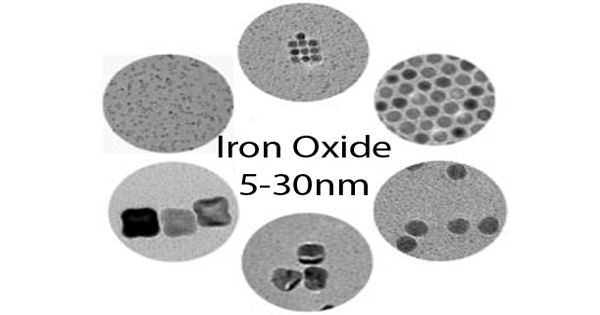Iron Oxide Nanoparticles
Iron oxides are common natural compounds and can also easily be synthesized in the laboratory. Iron oxide nanoparticles are iron oxide particles with diameters between about 1 and 100 nanometers. The two main forms are magnetite (Fe3O4) and its oxidized form maghemite (γ-Fe2O3). IO nanoparticles have attracted considerable interest due to their superparamagnetic properties and their potential biomedical applications arising from their biocompatibility and non-toxicity. They have attracted extensive interest due to their superparamagnetic properties and their potential applications in many fields (although Co and Ni are also highly magnetic materials, they are toxic and easily oxidized). Surface functionalized magnetic iron oxide nanoparticles (NPs) are a kind of novel functional materials, which have been widely used in biotechnology and catalysis.
An iron oxide nanoparticle, in nanotechnology, a particle is defined as a small object that behaves as a whole unit in terms of its transport and properties.
Iron oxide nanoparticles are used in the diagnostic fields, biomedical, and drug delivery. These are excellent candidates for biomedical applications such as magnetic resonance imaging contrast enhancement, tissue repair, immunoassay, detoxification of biological fluids, hyperthermia, drug delivery, and cell separation when they are appropriately functionalized. Applications of iron oxide nanoparticles include terabit magnetic storage devices, catalysis, sensors, superparamagnetic relaxometry (SPMR), high-sensitivity biomolecular magnetic resonance imaging (MRI), magnetic particle imaging (MPI), magnetic fluid hyperthermia (MFH), separation of biomolecules, and targeted drug and gene delivery for medical diagnosis and therapeutics. The magnetism of iron oxide nanoparticles has been used in cancer treatment and diagnosis, for example, thermoablation, hyperthermia, and contrast media in magnetic resonance imaging.

Iron oxides are chemical compounds composed of iron and oxygen. Altogether, there are sixteen known iron oxides and oxyhydroxides. The uses of these various oxides and hydroxides are tremendously diverse ranging from pigments in ceramic glaze, to use in thermite.
A nanoparticle is submicron moieties made of inorganic or organic materials, which have many novel properties compared with bulk materials. These applications require a coating of the nanoparticles by agents such as long-chain fatty acids, alkyl-substituted amines, and diols. They have been used in formulations for supplementation. Recently utilization of iron oxide-based nanomaterials with novel property and functionality is widely studied due to their small size, high surface area, and Magneti property. These nanoparticles have been developed as antibacterial, antifungal, and anticancer. For cancer treatment and diagnosis, iron oxide nanoparticles have been functionalized with drugs.
















